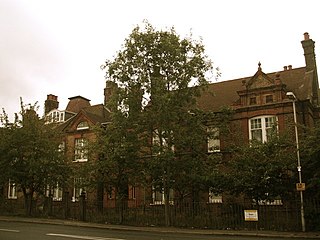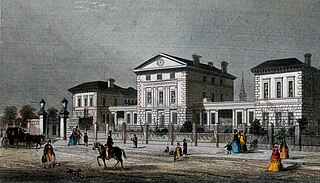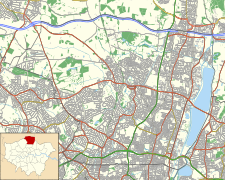
Palmers Green is a suburban area and electoral ward in north London, England, within the London Borough of Enfield. It is located within the N13 postcode district, around 8 miles (13 km) north of Charing Cross. It is home to the largest population of Greek Cypriots outside Cyprus and is often nicknamed "Little Cyprus" or "Palmers Greek".

The London Borough of Enfield is a London borough in Greater London, England. The main communities in the borough are Edmonton, Enfield, Southgate and Palmers Green. Enfield is an Outer London borough and forms part of North London, being the northernmost borough and bordering Hertfordshire to the north and Essex to the northeast. The local authority is Enfield London Borough Council, based at Enfield Civic Centre. The borough's population is estimated to be 333,794.
Winchmore Hill is a suburb and electoral ward in the London Borough of Enfield, north London, England, in the N21 postal district. The Winchmore Hill conservation area serves as the focal point of the district. Geographically, it is bounded on the east by Green Lanes, Barrowell Green, Firs Lane and Fords Grove. To the northwest, it is bordered by Grovelands Park. The southern boundary extends to part of Aldermans Hill, while the northern boundary reaches Vicars Moor Lane and Houndsden Road. Winchmore Hill is 8.9 miles (14.3 km) northeast of Charing Cross.

Whittington Hospital is a district general and teaching hospital of UCL Medical School and Middlesex University School of Health and Social Sciences. Located in Upper Holloway, it is managed by Whittington Health NHS Trust, operating as Whittington Health, an integrated care organisation providing hospital and community health services in the north London boroughs of Islington and Haringey. Its Jenner Building, a former smallpox hospital, is a Grade II listed building.

Grovelands Park is a public park in Southgate and Winchmore Hill, London, that originated as a private estate. The park is Grade II* listed on the Register of Historic Parks and Gardens.

Barnes Hospital in Cheadle, Greater Manchester, England, is a former hospital. It is on the border between Manchester and Stockport, near the A34 road in the middle of the complex interchange between Kingsway, the M60 and M56 motorway. The main building is Grade II listed, and lies on green belt land.

Queen Elizabeth Hospital is a hospital in Woolwich in the Royal Borough of Greenwich. It was opened in March 2001 and serves patients from the Royal Borough of Greenwich and the London Borough of Bexley. The hospital was built to accommodate the services previously provided at Greenwich District Hospital and Brook General Hospital, and is a Private Finance Initiative hospital. It is managed by the Lewisham and Greenwich NHS Trust.

Chase Farm Hospital is a hospital on The Ridgeway, in Gordon Hill, Enfield, run by the Royal Free London NHS Foundation Trust.

North Middlesex University Hospital, known locally as North Mid, is a district general hospital in Edmonton in the London Borough of Enfield. The hospital is managed by North Middlesex University Hospital NHS Trust.

World's End is an area in the London Borough of Enfield, southwest of Enfield Town, and runs north–south along the western edge of Grange Park.
Winchmore School is an 11–18 mixed, community secondary school and sixth form in Winchmore Hill, Greater London, England. It was established in 1956 as a secondary modern school and has been a specialist arts college since 2004.

St Ann's Hospital is a mixed healthcare campus in South Tottenham in the London Borough of Haringey, England, and is the headquarters for Barnet, Enfield and Haringey Mental Health NHS Trust. It also formerly housed the Haringey NHS primary care trust.
Greentrees Hospital was a hospital in Palmers Green, North London. Situated in Tottenhall Road, the hospital was built in 1902 as the Southgate Isolation Hospital, commissioned by Southgate Urban District Council.

Horton Hospital, formerly called Horton Asylum, was a large psychiatric hospital in the Horton area of Epsom, Surrey.

Lodge Moor Hospital is a former isolation hospital on Redmires Road in the Lodge Moor area of the City of Sheffield, England. The hospital which opened in 1888 and closed in 1994 initially treated Smallpox but soon broadened its treatment to other infectious diseases and in its latter years expanded to provide more general nursing, notably spinal injuries and chest medicine. At the time of closure, the hospital was operated by the Central Sheffield University Hospitals NHS Trust.
Barnes Hospital, on South Worple Way, East Sheen, in the London Borough of Richmond upon Thames, is a hospital managed by South West London and St George's Mental Health NHS Trust. It provides community and inpatient mental health services.

The 2014 Enfield Council election took place on 22 May 2014 to elect members of Enfield London Borough Council in London, England. The whole council was up for election and the Labour party retained overall control of the council, increasing their majority over the Conservative party by five seats.

Coppetts Wood Hospital was an infectious diseases isolation hospital in Muswell Hill, North London that operated from 1887 to 2008. It was used to treat, amongst other things, patients suffering from tuberculosis and Lassa fever.
James Purdon Martin (1893–1984) was a British neurologist.

A fever hospital or isolation hospital is a hospital for infectious diseases such as Scarlet fever, Tuberculosis, Lassa fever and Smallpox. Their purpose is to treat affected people while isolating them from the general population. Early examples included the Liverpool Fever Hospital (1801) and the London Fever Hospital (1802). Other examples occurred elsewhere in the British Isles and India.
















